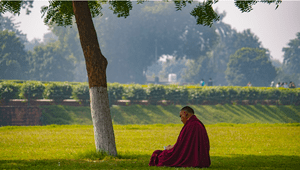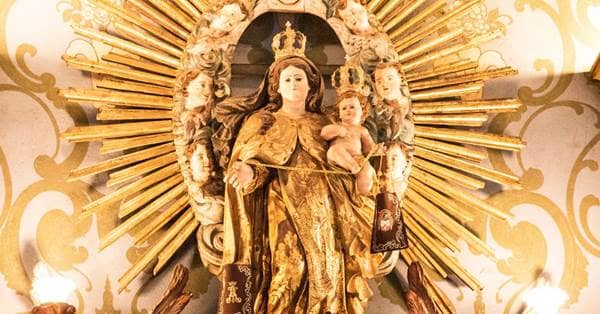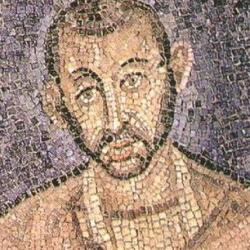
When non-Buddhists inquire about prayer, they are often referring to an individual's supplication before God—a speaking from one person to a God or gods about concerns in that person's life. Since most of Buddhist is nontheistic, meaning that they do not believe in a God or gods who would receive a person's individual request, it's hard to use the word prayer in the context of Buddhist devotion.
Nevertheless, the generally encouraging implications of this word have proved it useful as Buddhists seek to convey their practice of devotion. It is often used to describe the hopes and aspirations of the Buddha way, the desire that all creatures would find enlightenment and thus release from suffering. This spirit of "lovingkindness" finds expression in "prayers" of meditation and focused peace. In this sense, the Buddhist at prayer is seeking within for the resources to achieve Buddhahood and is visibly reverencing those who have already achieved it.
Most Buddhists, however, are not imploring a God to intervene on their behalf or change a present situation. They are internally expressing their longing for freedom from suffering and their hope of enlightenment. Buddhism contains within itself a visceral recognition that change in the world is up to the individual. Each person has within the germ of enlightenment, and each person alone is responsible for bringing it to fulfillment. There is no deity who is standing by to grant supernatural assistance. Thus prayer involves self-dedication and concentrated meditation on the issues of life and the choices for right living.
Buddhism, however, is not a monolithic religious philosophy, and in the 2,500 years since Buddha's life and teachings, the religion has developed three distinct sects: Theravada Buddhism, Mahayana Buddhism, and Vajrayana Buddhism. These three sects vary in their teachings around deities. Theravada Buddhism is nontheist, meaning it does not recognize supernatural beings who have absolute power over the matters of this earth. Mahayana Buddhism and Vajrayana Buddhism have developed pantheons of gods and deities, most of whom are buddhas and bodhisattvas. In these traditions especially, prayers are expressed toward these beings who may give aid.
Sometimes these expressions take the form of a mantra, a sacred word or text repeated with great frequency. In Mahayana Buddhism, the devotion to bodhisattvas has led to the common practice of reciting their names or the names of various Buddhas as an act of hope in the power of the bodhisattva to assist their journey into enlightenment. This is the Buddhist practice most like prayer.
In Tibetan Buddhism, mantras have been vested into a variety of material objects, like prayer wheels and prayer flags. Spinning the prayer wheels or seeing the wind whip the flags becomes the essence of the prayer, and the concept of an "answer" to these prayers becomes nonsensical. The prayers are simply the yearnings of all people for enlightenment, for freedom from suffering.
In many Chinese Buddhist communities, ancestors continue to have a role to play in the present life. These Buddhists will offer prayer to their ancestors in the form of burning incense or burning small paper tokens that depict material goods or money. These prayers are for the well-being of the ancestors, who then can create good for their living family members.
In Zen Buddhism, prayer most often takes the form of intense meditation. Zen Buddhist monks are strictly trained in this, and older monks conduct sesshin, periodic sessions that require the novice to sit for many hours each day in silent meditation. Sometimes they are taught to meditation on one or more sutra—verses or passages of sacred texts; sometimes they are called on to memorize long passages of classical texts; and other times they are given a koan—an enigma or paradox that cannot be solved by logic or rational thought and thereby pushes the practitioner to resolve it with intuition and enlightenment. None of this may look like prayer from other religious traditions because it involves neither a supplicant nor a divine recipient who can dispense special graces nor a specific request for help.
In every sect of Buddhism, festivals and pilgrimages are a primary means of expressing devotion. There are countless sacred sites that afford a Buddhist pilgrim the opportunity of deepening devotion, cultivating awareness, and imploring the goodwill of bodhisattvas.
Temples, stupas (monuments containing relics associated with different buddhas and bodhisattvas), sacred groves, and other shrines offer occasions for "prayer" That is, the pilgrim undertaking a journey to such a site is praying—expressing devotion, intensifying spiritual desire, and cultivating awareness.
Clearly, there is no single authoritative teaching on prayer in the Buddhist experience. The community shares many diverse and contradictory ideas, which have developed over centuries of cultural change and intermixing with other religious traditions. Prayer or no prayer, the Buddhist way is the pursuit of compassion and enlightenment. In their desire for this way, Buddhists' longings may be called "prayer."
5/14/2024 8:31:10 PM











